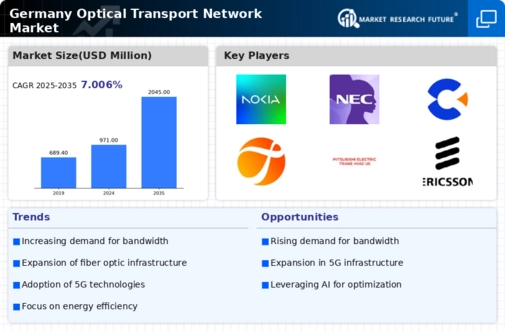Expansion of 5G Networks
The rollout of 5G networks in Germany significantly influences the optical transport-network market. With the anticipated increase in mobile data traffic, estimated to reach 1000x current levels by 2030, the need for advanced optical transport solutions becomes critical. 5G technology demands ultra-reliable low-latency communication, which can only be achieved through high-capacity optical networks. Telecommunications companies are thus compelled to upgrade their existing infrastructure to support this new technology. Investments in optical transport networks are expected to exceed €5 billion by 2026, reflecting the urgency to enhance network capabilities. This expansion not only facilitates faster mobile services but also stimulates growth in the optical transport-network market.
Adoption of Cloud-Based Services
The shift towards cloud-based services is reshaping the optical transport-network market in Germany. As enterprises migrate their operations to the cloud, the demand for high-capacity, reliable optical transport solutions intensifies. Reports suggest that cloud adoption in Germany is expected to reach 80% by 2026, necessitating robust optical infrastructure to support data transfer and storage. This transition drives telecommunications companies to enhance their optical transport networks, ensuring they can accommodate the increased data flow. The resulting investments in optical technology are projected to exceed €3 billion over the next few years, indicating a strong correlation between cloud adoption and the growth of the optical transport-network market.
Increased Focus on Cybersecurity
As cyber threats become more sophisticated, the optical transport-network market in Germany is witnessing a heightened emphasis on cybersecurity measures. Organizations are increasingly aware of the vulnerabilities associated with data transmission, prompting them to invest in secure optical transport solutions. The market for cybersecurity in optical networks is projected to grow by 15% annually, driven by the need to protect sensitive information. This trend compels optical transport providers to integrate advanced security features into their offerings, ensuring data integrity and confidentiality. Consequently, the focus on cybersecurity not only enhances the reliability of optical transport networks but also contributes to the overall growth of the market.
Rising Demand for High-Speed Connectivity
The optical transport-network market experiences a notable surge in demand for high-speed connectivity. As businesses and consumers increasingly rely on data-intensive applications, the need for robust bandwidth becomes paramount. Reports indicate that the demand for bandwidth is projected to grow at a CAGR of 20% over the next five years. This trend is driven by the proliferation of cloud computing, IoT devices, and streaming services, all of which require reliable and fast data transmission. Consequently, telecommunications providers are investing heavily in optical transport networks to enhance their infrastructure. This investment not only improves service quality but also positions companies to meet future demands, thereby driving growth in the optical transport-network market.
Regulatory Support for Infrastructure Development
Regulatory frameworks in Germany play a crucial role in shaping the optical transport-network market. The government has implemented policies aimed at promoting infrastructure development, particularly in underserved areas. These initiatives are designed to enhance connectivity and ensure equitable access to high-speed internet. As a result, investments in optical transport networks are likely to increase, with funding from both public and private sectors. The market is expected to benefit from an influx of €2 billion in government grants and incentives over the next five years. This regulatory support not only stimulates growth in the optical transport-network market but also fosters innovation and competition among service providers.



















Leave a Comment